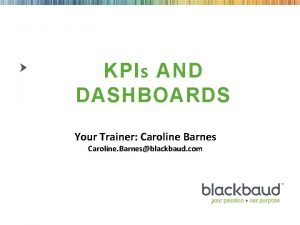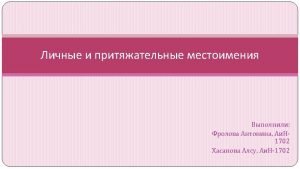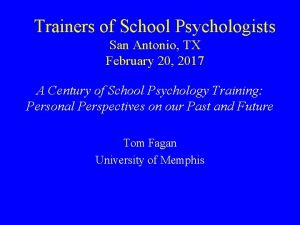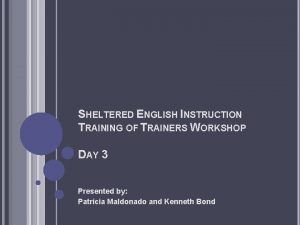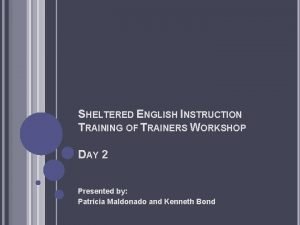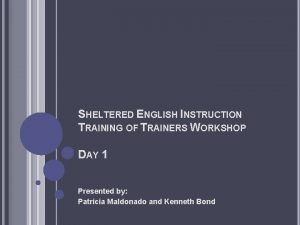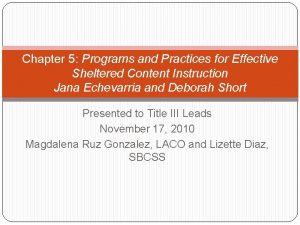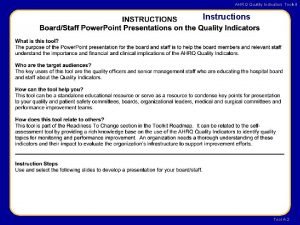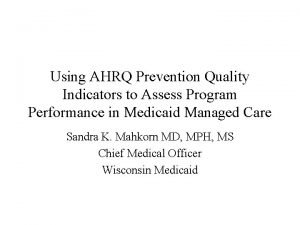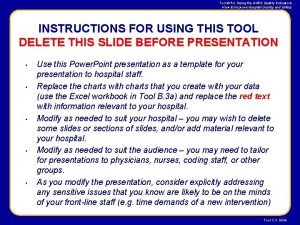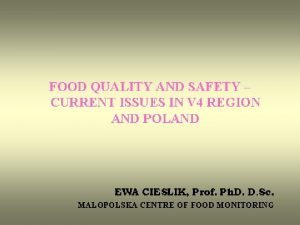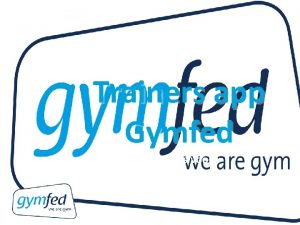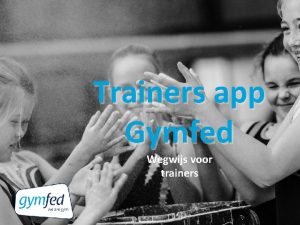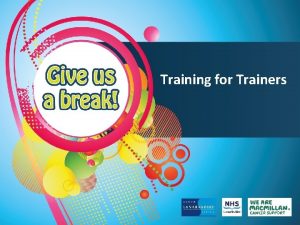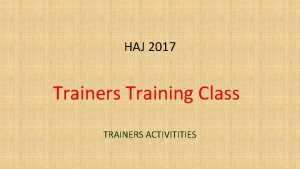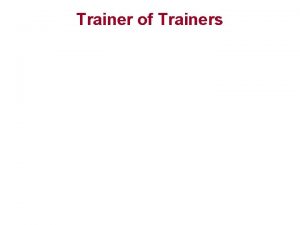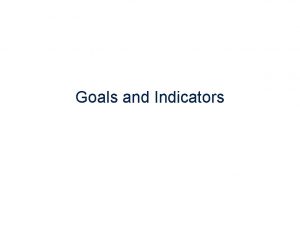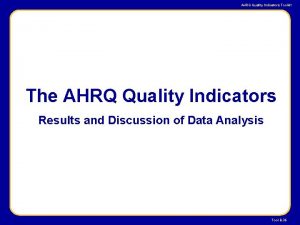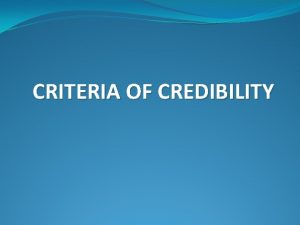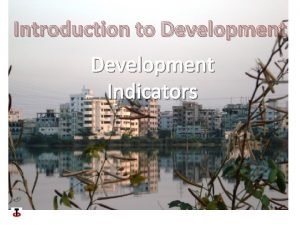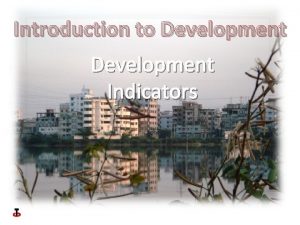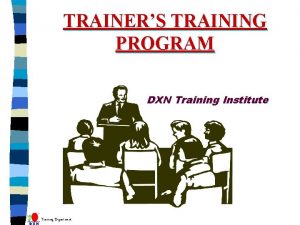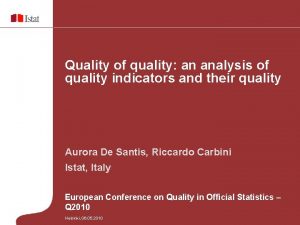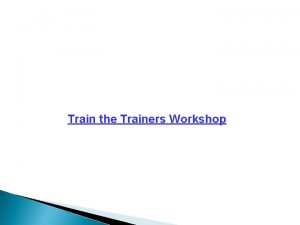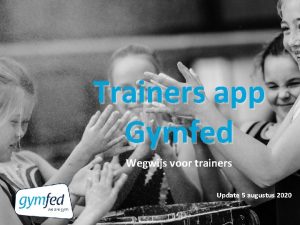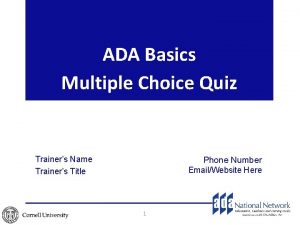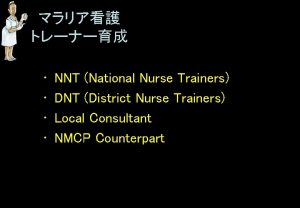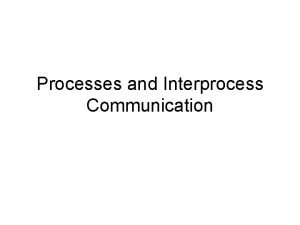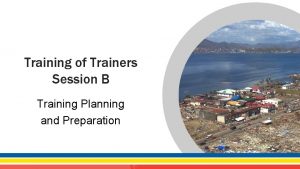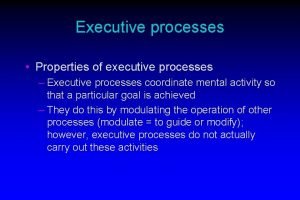TRAINERS AND TRAINING PROCESSES CRITERIA AND QUALITY INDICATORS

























- Slides: 25

TRAINERS AND TRAINING PROCESSES CRITERIA AND QUALITY INDICATORS TTnet Spain Marta Gonzalo 1

Background (I): New Teachers and Trainers Roles: Instructor, Tutor, Coach, facilitator. . . l The working environment and methods change and need continuous development. l Challenges from the demands of new and changing groups of trainees(e. g. Immigrants) l Educational movement from teaching to learning, flexible teaching methods, trainee centred. l 2

Background (II): l IT developments requires new competences. l Organizational changes require strategies for competence development and knowledge sharing l National legislation is reforming to give a legal frame to certify professional competences 3

Quality in Training: the Situation in Spain The control and development of quality in training is a matter of great interest to the Spanish public administration (national and regional governments) l Various initiatives in the quality area were established in recent years l “Quality law” for the general system of education was introduced recently. l Ttnet adopted as one main priority the Quality of Training linked to development of competences l 4

Ttnet-Spain working group on quality criteria and indicators for trainers and training processors MEMBERS: l National Employment Institute (Training of Trainers Service) Labour Ministry. l Regional Governments: Madrid, Valencia, Basque Country and Navarre. l Complutense University of Madrid 5

Objective l Deepen research into obtaining Criteria and Quality Indicators for Trainers and Training Processes. l Obtain models for quality applicable to training 6

1 Description of Methodology I l We used the Occupational Trainer professional certificate as a base (Royal Decree 7646/1997, 3 October, published in Official State Bulletin)* l This role can be broken down into the following four ability areas: 1. To Program training activities according with the other planned training activities and in agreement with the needs of the group 2. To provide learning opportunities adapted to both the characteristics of individuals or of the group and to their qualification needs, as well as to accompany and to direct, in a context-based way, the process of learning and qualification 7

Description of Methodology II 2 3. To verify that the objectives have been achieved and to evaluate the level of qualification reached. 4. To contribute actively to the improvement of the quality of training. l From the abilities needed for this professional role, we drew out the following key processes: 1. Programming 2. Implementation 3. Evaluation 4. Monitoring, improvement and innovation of the processes l Finally, the criteria and indicators were concreted to obtain a model with observable and measurable training elements. 8

Programming Process CRITERIA: 1 l Presentation and Availability – Indicators: aesthetics and delivery to the students 2 l Coherence, Variety and Adaptation of the Objectives: – Indicators: all areas included. …formulated with different levels of precision…. 3 l Coherence, Variety and Adaptation of Contents: – Indicators: structured in modules…. . 9

Programming Process (continued) CRITERIA: 4 l Variety and Methodological Adaptation: – Indicators: concrete and varied specification…. 5 l Exact timing: – Indicators: all of the modules…. are timed according to…. 6 l Adaptation and Accuracy of the evaluation system: – Indicators: evaluation includes the ‘what’, the ‘how’ and the ‘when’…. . A reflection upon the points is present… 7 l Preparation of Teaching Methods: 8 l Preparation of Teaching Material: FOR MORE INFORMATION. . . See table presented in Appendix I of the documentation 10

Implementation Process l Criterion 1: Teaching Skills 11

Some indicators (of the 40 set out): – Presents session objectives clearly and precisely – States the work method to be followed – Explains the meaning of technical and difficult words – Gestures are expressive and dynamic – Whole class involved – Elicits interventions from the students 12

Implementation Process l Criterion 2: Programming /Implementation Relationship Indicators: The theoretic-practical contents imparted match those programmed ü The timeframe set out in the programme is followed ü The proposed objectives are fulfilled ü 13

Implementation Process l Criterion 3: Monitoring of students Indicators: % of students present 10´ from the beginning of class. ü % of students who attend classes ü All students who begin the course finish it ü 14

Implementation Process l Criterion 4: Student satisfaction Indicators: % of student satisfaction with the course ü % of student satisfaction with what they are learning ü % of student satisfaction with classroom atmosphere ü % of student satisfaction with manner and guidance of the teacher ü 15

Implementation Process l Criterion 5: Assessment, tutorials and individual guidance: Indicators: ü Nº of sessions carried out ü Satisfaction level of the students assessed FOR MORE INFORMATION. . . See table presented in Appendix II of the documentation 16

Evaluation Process CRITERIA: l Level of adaptation to fit the student with the training requirements of the course – Indicators: existence of instruments… recording of data obtained…. Report l Degree of progress and level of learning in continuous evaluation: – Indicators: existence of instruments…. variable… adjusted to contents…. proposals documented and registered. . . 17

Evaluation Process (continued) CRITERIA: Final progress levels for the course – Indicators: existence of instruments… adjusted to fit contents…. performance %. . . final reports l Application or transfer: – Indicators: % of those finding jobs…. relevance to subject… level of application of knowledge gained during course in employment. . . l FOR MORE INFORMATION. . . See table presented in Appendix III of the documentation 18

Monitoring and Quality Improvement Process l Criterion 1: Course report with proposals for the improvement of the training process and for the revision of documentation, teaching methods and materials Indicators (2 of the 6 proposed): Presentation of a justified revision of materials ü Incorporation of updated documentation and teaching methods ü 19

Monitoring and Quality Improvement Process l Criterion 2: Participation in advanced courses Indicators: Nº of courses carried out in a year ü Adaptation of the course (or courses) to the teaching activity of the trainer. ü 20

Monitoring and Quality Improvement Process l Criterion 3: Participation in other professional activities (congresses, seminars, sector fairs, etc. ) Indicators: Nº of professional activities attended in a year. ü Adaptation of the activity (or activities) with the teaching duties of the trainer. ü 21

Monitoring and Quality Improvement Process l Criterion 4: Study (report) on companies in the sector in order to facilitate post-course job-placement Indicators (2 of 4 proposed): Nº of companies in the sector classified by size and business activity. ü Inclusion of information relating to each company: address, telephone. . . ü FOR MORE INFORMATION. . . See table presented in Appendix IV of the documentation 22

CONCLUSIONS: l Contribution towards giving a more concrete and useful vision of how to test the abilities of quality professional trainer. l Difficulties When attempting to make operational some concepts (e. g. ”coherence in Programming” or “motivation of the students”) 23

NEXT STEP: l To implement these quality approaches on the professionalisation of trainers in two levels: – A procedure to select quality professional trainers – A design for the training of trainers 24

FUTURE AREAS FOR CONSIDERATION: To make contact with other people who, at trans-national level, can be working on these points on a European level. l To establish the deepening of research into specific criteria and indicators for the specific processes of the open and distance trainer as a new line of future investigation. l 25
 Concurrent processes are processes that
Concurrent processes are processes that Trainersapp
Trainersapp Kpi for trainers
Kpi for trainers Cdm trainers
Cdm trainers Look at your trainers
Look at your trainers Le caf trainers
Le caf trainers Trainers of school psychologists
Trainers of school psychologists Personal trainers: session 2
Personal trainers: session 2 Sheltered 2 trainer
Sheltered 2 trainer Sheltered trainers
Sheltered trainers Sheltered trainers
Sheltered trainers Vertical integration course for trainers
Vertical integration course for trainers Sheltered trainers
Sheltered trainers Ahrq quality indicators
Ahrq quality indicators Prevention quality indicators
Prevention quality indicators Ahrq quality indicators toolkit
Ahrq quality indicators toolkit Quality criteria
Quality criteria Criteria of food quality
Criteria of food quality Quality assurance vs quality control
Quality assurance vs quality control Basic concept of quality control and quality assurance pdf
Basic concept of quality control and quality assurance pdf Quality management pmp
Quality management pmp Pmp gold plating
Pmp gold plating Quality assurance cycle in nursing
Quality assurance cycle in nursing Quality improvement vs quality assurance
Quality improvement vs quality assurance Juran's three role model
Juran's three role model Quality is free
Quality is free


